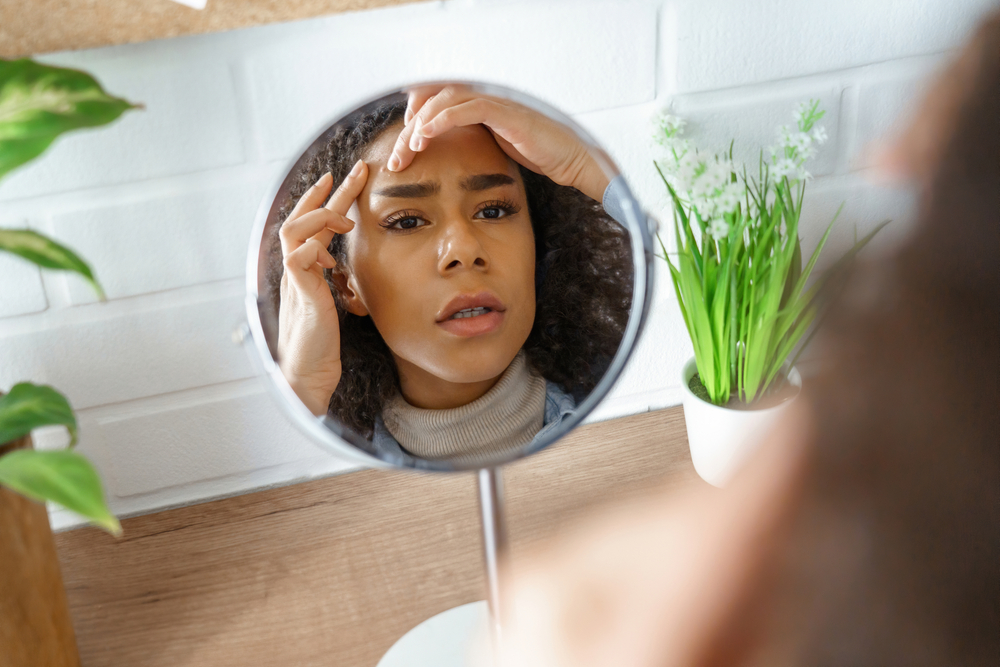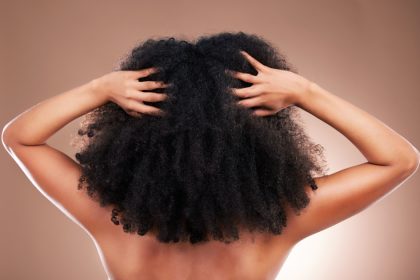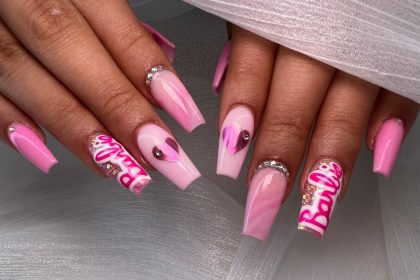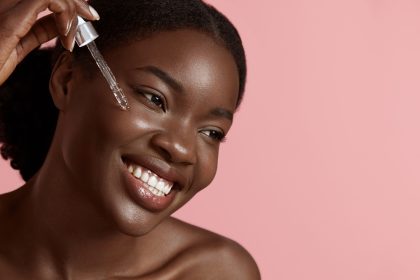Your TikTok feed is flooded with teenagers promising to eliminate your pores forever using kitchen ingredients and aggressive scrubbing techniques that would make dermatologists weep. What should be harmless beauty content has turned into a misinformation factory where basic skin anatomy gets twisted into viral lies that are causing real damage to millions of faces.
The pores on your face have become TikTok’s favorite villain, blamed for every skin insecurity and targeted by increasingly desperate DIY treatments that ignore fundamental biology. These tiny openings that keep your skin healthy have been rebranded as flaws that need to be erased, shrunk, or aggressively cleaned out using methods that often make skin problems worse.
The disconnect between what actually works for pore care and what gets millions of views on social media has created a generation of people who are actively sabotaging their skin while thinking they’re improving it. The most popular pore advice on TikTok ranges from useless to genuinely harmful, and it’s time someone explained why your skin doesn’t need to be saved from its own basic functions.
Your pores aren’t broken and don’t need fixing
Pores exist for crucial biological reasons that TikTok creators seem to have forgotten in their quest for viral content. These tiny openings allow your skin to release sweat for temperature regulation and produce sebum that protects your skin barrier from environmental damage and bacterial infections.
The obsession with “perfect” poreless skin ignores the fact that visible pores often indicate healthy skin function rather than skin problems. Your pores are actively working to keep your skin moisturized, protected, and able to regulate temperature effectively throughout the day.
Different areas of your face naturally have different pore sizes based on oil gland density and genetic factors that have nothing to do with your skincare routine or cleanliness habits. The T-zone typically has larger, more visible pores because it contains more sebaceous glands that produce the oils your skin needs.
Age-related changes in skin elasticity and collagen production can make pores appear larger over time, but this is a normal part of aging rather than a sign that your skincare routine is failing or that you need more aggressive treatments.
The genetic component of pore size means that some people will always have more visible pores regardless of their skincare efforts. Fighting your natural skin characteristics with harsh treatments often creates more problems than it solves.
The shrinking pore myth is causing real damage
Social media has convinced millions of people that pore size is controllable through skincare products and routines, but pores don’t have muscles and can’t be permanently shrunk through topical treatments. This fundamental misunderstanding leads people to waste money and damage their skin chasing impossible results.
Over-exfoliation from trying to “shrink” pores destroys the skin barrier and can actually make pores appear larger due to inflammation and increased oil production. The aggressive scrubbing and harsh chemicals promoted in viral videos often create the exact opposite of the intended effect.
The constant pressure to minimize pore appearance leads to product overload where people layer multiple active ingredients that can cause irritation, sensitivity, and compromised skin function. This chemical overload often makes skin look worse rather than better.
Retinoids and other ingredients can improve skin texture and make pores appear smaller by increasing cell turnover and reducing oil buildup, but they don’t actually change pore structure. The improvement is temporary and requires ongoing use, not a one-time miracle transformation.
The disappointment that comes from expecting dramatic pore reduction often leads to increasingly desperate measures and product jumping that prevents skin from adapting to consistent, gentle care that might actually provide modest improvements over time.
Steam and ice don’t control your pores like doors
The persistent myth that heat opens pores and cold closes them has led to countless videos of people steaming their faces and then applying ice, based on a complete misunderstanding of how pores function. Pores don’t have muscles and can’t open or close on command like tiny doors responding to temperature changes.
Heat can soften the sebum and debris inside pores, making it easier to remove buildup during cleansing, but it doesn’t physically alter pore structure or create opportunities for deeper cleaning that wouldn’t exist otherwise. The “opening” effect is really just making existing contents more removable.
Ice and cold water can temporarily tighten skin through vasoconstriction, creating a temporary appearance of smaller pores, but this effect lasts only minutes and doesn’t create lasting changes to pore structure or function. The “closing” is purely cosmetic and temporary.
The extreme temperature changes promoted in viral skincare routines can actually irritate sensitive skin and cause broken capillaries or increased sensitivity. The shock of going from hot steam to ice water is more likely to cause skin problems than provide benefits.
Professional extractions performed by estheticians work because of proper technique and sterile conditions, not because steam magically opens pores. The temperature preparation is just one small part of a comprehensive treatment approach.
Those black dots aren’t dirt and shouldn’t be eliminated
TikTok has demonized sebaceous filaments, the tiny dark spots that naturally occur in pores, by misidentifying them as dirt or blackheads that need aggressive removal. These structures are normal parts of skin function that help distribute protective oils across the skin surface.
Sebaceous filaments will always return after extraction because they’re part of normal skin function, not foreign material that can be permanently removed. The aggressive removal techniques promoted on social media often cause more irritation and enlarged pores than leaving them alone.
True blackheads are different from sebaceous filaments and are characterized by completely blocked pores with oxidized debris. Most of what people see on their noses and identify as blackheads are actually normal sebaceous filaments that don’t require treatment.
Pore strips, DIY extractions, and aggressive squeezing can damage the skin around pores and actually make them appear larger over time. The temporary satisfaction of removing visible debris often leads to increased problems and more noticeable pores.
The obsession with completely clear pores ignores the fact that some level of sebaceous material is necessary for healthy skin function. Completely eliminating all visible pore contents often leads to overproduction and rebound effects.
Filtered skin is creating impossible standards
Beauty filters and editing apps have created unrealistic expectations for skin texture that are literally impossible to achieve naturally. The “poreless” skin shown in filtered content doesn’t exist in real life and creates standards that lead to disappointment and skin damage from trying to achieve the impossible.
The psychological impact of constantly seeing filtered skin makes normal, healthy pores seem like major flaws that require correction. This distorted perception leads people to see problems where none exist and to seek solutions for normal skin characteristics.
Influencers who promote pore treatments often use filters or editing even while claiming to show natural results, creating misleading before and after comparisons that make ineffective treatments appear successful. This deceptive presentation fuels unrealistic expectations and product sales.
The normalization of filtered skin in beauty content makes it difficult for people to recognize that visible pores are normal and healthy rather than signs of skin problems that need to be fixed through aggressive treatments or expensive products.
Young people who grow up seeing primarily filtered skin representations may never develop realistic expectations for their own skin texture and may spend years trying to achieve standards that don’t exist in nature.
Science-based pore care actually works
Gentle chemical exfoliation with salicylic acid or glycolic acid can help remove buildup inside pores without the irritation and damage caused by physical scrubbing or aggressive extractions promoted in viral videos. These ingredients work gradually to improve skin texture and reduce the appearance of enlarged pores.
Consistent moisturizing helps maintain skin barrier function and can actually make pores appear smaller by keeping skin plump and healthy. The moisture-stripping routines promoted on social media often make pores more noticeable by compromising skin texture and elasticity.
Sunscreen prevents UV damage that breaks down collagen and elastin, helping to maintain skin structure that keeps pores looking smaller over time. The anti-aging benefits of sun protection include maintaining skin firmness that supports smaller-appearing pores.
Clay masks can absorb excess oil and remove surface debris without the harsh effects of pore strips or aggressive extraction methods. These treatments work best when used occasionally rather than as daily attempts to eliminate normal pore contents.
Professional treatments like chemical peels and microneedling can provide more significant improvements in pore appearance than any DIY method, but they require proper training and equipment that can’t be replicated at home with kitchen ingredients.
The most effective pore care focuses on overall skin health rather than targeting pores specifically. Healthy skin with good barrier function, adequate moisture, and protection from sun damage naturally minimizes the appearance of pores without requiring aggressive interventions or unrealistic expectations for perfection.















